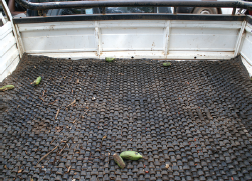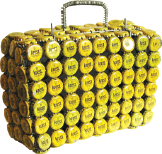Are Humans Parasites on the Ecosystem?
Since the Intergovernmental Panel on Climate Change’s 6th Report 4 was released on August 9th, 2021 just prior to the opening of cop26 (“cop” is an acronym for “Conference of the Parties”), the un’s Glasgow Climate Summit, there has been a growing crescendo of environment coverage in the worldwide media. Unfortunately, this has yet to transform industrial capitalism a, the socio-economic juggernaut John Zerzan refers to as a “death trip” for our planet. 5 Documentaries about the circular economy b, like 2019’s Closing the Loop, 6 which follows Cambridge fellow Wayne Visser on a global investigation of efforts to abandon linear production (take/make/dispose), seem tone deaf in the way they substitute methodological fixes for systemic change. The many participants profiled in these narratives are so busy pursuing technical solutions to environmental crises, that at no point do any of them question the model of industrial-grade economies of scale pervading the global marketplace. It is taken for granted that this model is our ultimate salvation, rather than something that could be smaller, leaner, or that could operate closer to local production.
Industrial capitalism arose in and across several economies in the late 19th and early 20th centuries, as advances in large-scale, mechanized machinery made it possible to mass produce, distribute and monetize large amounts of goods relatively cheaply and quickly in multiple markets across the globe. As it evolved, it afforded opportunities for a select few to own or control enormous portions of industrial systems and the resources that fueled them while simultaneously ensuring a marked division of labor. This had the effect of concentrating enormous wealth in the hands of individuals or organizations, which allowed them to effectively assert and sustain monopolies to control many industries and socio-cultural features and conditions.
As opposed to an economy that is structured linearly, which involves harvesting materials from the Earth, transforming them into saleable goods and then discarding them as waste, an economy that is structured in a so-called circular manner seeks to eliminate waste by using no longer useful or desirable products as resources from which to make new ones. The essential goal of a circular economy is to avoid the production of waste from the outset of the development, design and production process.
Whether they are talking about fast-fashion, food waste, recycling initiatives, or waste to energy, the experts all avoid the elephant in the room: our planet’s carrying capacity. This makes sense for corporations that are driven by bottom-line exigencies, especially publicly traded ones that must meet legal and financial obligations to their shareholders, but for the natural environment it has been disastrous. Here, the psychosis of growth feeds the insanity of wealth concentration for the benefit of a few.
This would be a “wicked problem” 7 custom-made for design practitioners were it not for the fact that designers are complicit in fueling the corporate hysteria that has resulted in damage to the collective commons. The design profession has evolved into production siloes that focus on magnitude of production at the expense of the environment. In the fifty years since Papanek’s Design for the Real World, design’s combined professions (in architecture, fashion, communication, experience, environmental, and industrial design) have ridden the wave of short-term profit right out of the 20th century only to crash into the cataclysm of incipient ecological collapse.
Design criticism has been slow to respond, or even uncritical of this phenomenon. In fact, much of design journalism has often played the role of public relations in the ways it has promoted the design, manufacture, marketing, and history of industrial production without accounting for their adverse effects. Books like Thomas Rinaldi’s Patented (2021), which reproduces the patent drawings of 1,000 inventions ranging from rockets to fountain pens, including the plans of some of the 20th century’s most heralded designers, are celebrated triumphally with no mention of how these products affected landfill volume, depleted resources, or increased energy consumption. While Rinaldi’s book might be less obtuse than coffee table books like Taschen’s 1000 Chairs (2013), such celebrations of industrial novelty only support the linear take, make, and dispose business-as-usual track we’ve been trundling down for 150 years.
An alternative exists. In the craft-based societies of Africa, examples abound of the ways people extend, supplant, and imagine substitutes to economy-of-scale production. I argue that this diy mentality is endemic to societies that have not been bloated by plethora-of-choice commerce, which encourages people who have little to substitute locally made objects for bespoke, industrially produced international brands. Such alternatives obviously have limits. Certainly, to my knowledge no African has come up with a substitute for the microelectronics in an iPhone. But in many more ways than Western society has been willing to admit, ranging from William Kamkwamba’s homemade electricity-generating windmill in Malawi 8 to the jerry-rigged jugaad vehicles of India, tinkered together in the “making do” meaning of that word, developing world peoples have proved resourceful under challenging circumstances. I would like to propose a one-to-one comparison of ten everyday African items to ten largely industrially produced and distributed items that I believe demonstrates the limitations of our Western design mindset. While there could be craft examples used to support my argument that have been sourced from other parts of the world, I limit myself to Africa, as that is where my first-hand research took place.
Costume Jewelry
|
Cobalt blue with Aventurina Murano glass beaded necklace ($49.95) Italian glassmakers have produced handmade beads since the 13th century. The process generally entails snipping glass tube into small sections and inflating them. Glass making requires intensive energy. |
Rolled paper beads ($10) African women have produced rolled paper beads since the 1980s as an income supplement. Varnished paper beads are not only attractive, but recycle an obvious waste material. |
Truck Bed Liners
|
Chevy rubber truck bed mat ($99-$499) Bed mats and bed liners can be purchased either from the vehicle manufacturer, as with this one, or from a variety of independent brands. They are available for most makes and model years, and range in price from $100 for a mat to $500 for a custom full liner. |
A truck bed liner seen in Kampala, Uganda This bed liner was made from strips of used tires. Tire treads are for sale on the roadside in Africa, and are used in a variety of applications. The overall cost of this bed liner is unknown, but is easily less than $100. |
Clothing Irons
|
Proctor-Silex electric iron (about $30) In addition to being more expensive than many African households can afford, this electric iron uses power that is not only dear, but only semi-available. Its only real advantage is its steam capability, but this can be accomplished with any iron using a damp towel. |
A terra cotta charcoal iron made by John Kituttu, Mbale, Uganda Climate change affecting snowfall in the Ruwenzoris has also reduced the level of Lake Victoria, the main source of hydropower for Uganda and Kenya. As a result, electric irons have been replaced in many areas by charcoal ones. |
Durable Milk/Yogurt Containers
|
Refillable glass milk bottle Refillable glass bottles have largely been replaced by either HDPE jugs, or “Tetra” style waxed cartons. The glass is more elegant than its replacements, displaying the purity of its product. Requiring more energy inputs to make, its 25x refillable capacity more than offsets its production costs. Its use is now rare. |
Ankole wooden bottle The Banyankole people occupy parts of contemporary Rwanda and Uganda. They are pastoralists, herding Ankole long-horned African cattle. This vessel is carved wood, but these can also be made of ceramic. Beautifully balanced with a heavy bottom, they do not tip over, and the woven cap keeps insects away. |
Lunchboxes
|
Aladdin Steve Canyon Lunch Box (originally $10) Stamped metal lunch boxes with television or cartoon graphics are fond memories for many American kids. From 1950 to 1987 Aladdin was the industry leader for branded tin-litho lunch boxes— mine was a 1956 version of the Errol Flynn Robin Hood. This 1959 example shows Milton Caniff’s Steve Canyon, who was not only a funny paper stalwart from the ’50s to the ’80s, but also had a television series starring Dean Fredericks. |
Krest Box ($10) Like the antique milk bottle listed above, many contemporary drink containers in Africa are refillable, creating a plague of sharp crown cap waste on the ground. On the other hand, the caps are a readily available resource. This Kenyan latching carrier serves the added function of socially conscious upcycling. |
Design and Conviviality
Perhaps the most radical critique of the effects of industrial society of the past fifty years is found in Ivan Illich’s 1973 book Tools for Conviviality, in which Illich redraws post-industrial society in terms of convivial modes of production. c The notion that an average person deserves the opportunity to make decisions about a healthful life for themself and their family closely aligns with Illich’s criticism of corporations, which are in a continual grab for increased power, as well as of the educated professions that tailor medicine, finance, management, education, science, and the law to expanded industrial growth.
c. Illich argued for people’s need to take control of the tools and processes of production that shaped their everyday lives, and deemed this approach “convivial production.” He believed that their ability to participate in these processes would allow them to live more meaningful and productive lives.
At the dawn of the environmental movement, Illich realized more than many the importance of self-regulation and suggested the “universal renunciation of unlimited progeny, affluence, and power on the part of both individuals and groups.” 9 Of course, the gulf between obscene affluence and wretched poverty that Illich observed during his time in New York City, Puerto Rico, and Mexico has only widened as our obsession with industrial growth and economic expansion has further polarized society.
A convivial society, as opposed to the utilitarian one we currently possess, would practice frugality, recognizing that collectively agreed upon limits to acquisition could be applied to the general good. While this will seem an anathema to people obsessed with wealth, societies throughout history have consistently proven the general benefits of collectivity, from the Roman aqueduct system or the construction of medieval cathedrals to the development of the Interstate highway system. Freedom cannot mean “freedom without limits,” a concept Libertarians do not quite understand, as evidenced by the absurd level of firearm-related deaths in America (nearly 49,0000 in 2021 according to the cdc). Illich was not interested in reducing industrial production to the highest endurable levels the environment could tolerate, an action that would result in what he termed a “kakotopia,” or malignancy, 10 but in a social reconstruction and a return to a balanced relation to the planet where people ceased to be “destructive consumers” enslaved by their tools.
Is Illich’s alternative practicable? Advocating for a pace of life of under 20mph and a scale of life more humane than modern megalithic metropolises has not caught on, obviously. But the stress resulting from modernity’s tempo, and the subjugation of individuals to industrial society’s gigantism has resulted in the deterioration of the biosphere and of our collective mental and socio-cultural health. What good is a vehicle that can attain speeds of 80 mph in the gridlock that exists around most modern cities? Illich called for “counterfoil research” to create guides to detect “stages of murderous logic” in tools, and the development of tools that “optimize the balance of life.” He wrote, “When maddening behavior becomes the standard of society, consider cellphone obsession, people learn to compete for the right to engage in it. Envy blinds people and makes them compete for addiction.” 11
Illich believed a redesigned world was possible through the collective and judicious use of clear language and the demystification of law and science. He foresaw that, as population reached the limits of growth, and industry strained to provide beyond the planet’s carrying capacity, social cohesion would fail on many levels and the political and economic powers governing corporate-based states would face a crisis many times worse than the Great Depression. Such governments have co-opted both the law and the judiciary to promote the myth of unending industrial growth. This myth has saddled us with the many and growing examples of climate-change damage to society and the ecosphere we are witnessing. In order to bring about a social “inversion,” where people agree and apply a process to convivially control society’s tools, we will need to de-bureaucratize the law, and effect “the passage of laws setting upper limits to productivity, privilege, professional monopoly, and efficiency.” 12 Although passage and policing of such laws will seem like pie-in-the-sky to some, international environmental agreements like the Montreal Protocol on ozone, the International Criminal Court’s handling of war criminals, or the Magnitsky Act’s 13 blacklisting of human rights abusing international money launderers proves that cooperation and diplomacy create positive change. Closer to home, Social Security and Medicare are good examples of taxation for cooperative social benefit.
Is Ecological Apocalypse Avoidable?
Of course, it’s not possible to make a direct comparison between
Sandals
|
Foam rubber flip flops ($3) These foam rubber single thong sandals are cheaply mass manufactured and exported from Asia by the millions. Intended for no more than a season or two, they are soon replaced with a new pair, often becoming unused landfill. |
Lugabire, or million-milers ($1) Tire sandals, made from repurposed Marshall sidewalls, are much more durable. Available for less than a dollar, they are worn by the working poor, a common sight on the streets of many African capitals. |
Hats
|
Hyp Gear all cotton baseball cap ($20) This common baseball cap is made of black dyed cotton. It is comfortable, although it fades to brown in time, and cotton dying is destructive. Typical of such hats, it is mass produced, and at $20 is not cheap. Mass production of cotton is one of the world’s greatest polluters. |
Bark cloth hat ($10) Bark cloth is produced across central Africa from fig tree bark, a renewable resource. This craft item, with its cylindrical design, is similar to a 19th century baseball cap, but is made from more durable material. |
Toys
|
Buddy-L tanker (originally $7) The Texaco truck was a limited-edition licensed toy manufactured in the 1960s. Made of enameled pressed steel, it is durable enough to outlast generations of play to ultimately become a valuable collectible (today $100+). |
Wheeled jet ($5) This jet was fashioned by a Kenyan artisan from a re-purposed vegetable oil drum (spout visible on the tail). Swept wing with slung mount engines, the wheels are made from the tops of spray cans glued together, a collectible for a truly recycled future. |
Shirts
|
Nike Pro Stretch Men’s T ($28) Nike’s fast-fashion mass manufactured sweat-wicking T is everything if you are going to be around water. Problem is, it is brought to you by a company with a checkered history of paying low wages to developing world workers so high-paid professional athletes can look good promoting its stuff. |
Ghanaian Men’s Shirt ($25) This orange and green shirt is made of batik-dyed cotton with all its flaws and imperfections. Batik has a long history in West Africa. Collarless, with a buttoned pocket, it is intended as a custom high-end craft garment, a not unusual sight on the streets of African cities. |
Kerosene Lanterns
|
Coleman “Sunshine of the Night” Lantern ($100+) This Big Hat Model 228F from 1967 is a fine example of the type. Made of heavy-duty steel, Coleman lamps were designed to be pressure-pumped to release an even spray of fuel to the flame. These beautiful lamps have an international collector’s club. |
Hurricane Lamp ($5) A lantern made from a recycled milk tin, the dome is sheet metal, with the globe made from cut strips of plate glass. The flame emits from a piece of rope soaked in the fuel. Not a high-end item, but practical. |
mass industrial manufacturing and craft production. Even in William Morris’s time (1834-1896) industrial production had far surpassed craft, with Morris self-admittedly “ministering to the swinish luxury of the rich.” 14 In the century and a half since then we have had plenty of time to assess the effects of the rise of mass consumerism, and its’ tragic aftermath.
As our date with the apocalypse rushes toward us— an ecological train wreck for which no one wants to accept responsibility— and human population continues to expand, there are many who are unwilling to abandon the mass production model. Some argue that while it has lifted millions of the world’s people out of poverty, it has also stranded billions on the bottom of the wealth pyramid. The sad truth that the planet’s carrying capacity is not sufficient to support 7+ billion humans at current Euro-American levels of affluence still does not dissuade many from attempting to improve their material situation, while billionaires are obsessed with consolidating their excessive wealth.
Efforts to correct the problem of industrial overproduction through on-demand manufacturing and niche marketing are only part of the solution. Recycling or upcycling have proven too limited to effect change, and downcycling is more often the real end of product life. African markets are jammed with bales of exported used clothing. Off-shoring recyclables is proving just as grotesque as ocean dumping of trash. Pumping industrial waste into concrete manufacture as an effort of last resort, like schemes for carbon sequestration in mines and wells or using sewer sludge as fertilizer, only expands the crisis. Cement and concrete are among the world’s largest CO2 emitters, and heavy metals from waste sludge do not make for healthy soils. Even our renewable resources, like wind turbines and solar panels, create problems when multiplied to the number that would be needed to maintain current levels of usage. Polysilicon manufacture, and rare earth extraction pose their own issues, not to mention the land-use debates of solar or wind farm siting. Reusing and recycling, while necessary, really need a very large push from conservation and industrial reduction. The “collaborative consumption” of the sharing economy, as capitalized by Airbnb, Zip Car, and Angi has not yet materialized in manufacturing. The primary problem for “sharing” in manufacture has always been a matter of supply-chain verification. In other words, a manufacturer like Herman Miller can neither guarantee nor insist that its subcontractors are pursuing sustainable practices.
I have been asked to propose ways in which designers could begin to develop convivial approaches to the crisis. My immediate response would be to replace competition with cooperation. A start might be to cease boasting about the Fortune 500 corporations one has worked for, recognizing that such entities are a major part of the problem. Jointly owned companies are primarily beholden to their shareholders, are focused on market domination, and spend millions attempting to lobby legislation that will secure continued short-term profits. Another idea could be to stop supporting trade shows and conferences with exorbitant attendance fees, instead donating the high cost of participation to environmental, community, or social justice initiatives, and reducing your air-travel carbon footprint in the balance.
Designers want to know that their peers are developing responses to collectively agreed upon problems, and some design writers have attempted to address our worsening situation. Anne Chick and Paul Micklethwaite’s Design for Sustainable Change 15, and Elizabeth Resnick’s Developing Citizen Designers 16 are anthologies that compile suggestions and case studies some will find useful. For more thorough studies, one should read McDonough and Braungart’s Cradle to Cradle 17, or Julia Watson’s Lo-TEK, 18 this last a look at some amazing examples of indigenous design that suggests the potential of convivial approaches. But it needs to be stated that many of the best examples of low-impact social design solutions, from neighborhood tool-sharing to community barn-raising, from urban-foraging to second-hand clothes shopping will not be found in books, but are common sense solutions for effectively meeting age-old human needs. The point is that non-formally trained individuals have much to teach professional designers trapped in an industrial capital rat race, so I am reluctant to suggest that solutions lie within the professions.
The example comparisons that have showcased in this article exemplify instances of how small production wedded to imaginative repurposing can create not only beauty, efficiency, and value, but self-sufficiency for their creators. They preserve local and cultural identity while reducing the impact of large-scale waste production. We must abandon our hegemonic insistence upon the reasonableness of Western design and manufacturing to dominate world markets. Overproduction, long the holy grail of industrial capitalism, is already shaping up to be its epitaph. It’s past time for us to accept that progress, at least in a manufacturing sense, is not our most important product.
Notes
- Stairs, D. “Biophilia and Technophilia: Examining the Nature/Culture Split in Design Theory.” In The Designed World: Images, Objects, Environments, edited by R. Buchanan, D. Doordan, and V. Margolin, pgs. 339–345. Oxford, UK: Berg Press, 2010. ⮭
- Stairs, D. “Designing Ourselves to Death.” In Ethics in Design and Communication: Critical Perspectives, edited by L. Scherling and A. De Rosa. London, UK: Bloomsbury, 2020. ⮭
- Stairs, D. “Okuwangaala: The Persistent Vitality of the Vernacular,” in Design Issues, 28.3 (2002): pgs. 70-87. ⮭
- Lee, H. et al. AR (Assessment Report) 6 Synthesis Report: Climate Change 2023. Intergovernmental Panel on Climate Change, 13 March, 2023. Online. Available at: https://www.ipcc.ch/assessment-report/ar6/ (Accessed May 26, 2023). ⮭
- Zerzan, John, Twilight of the Machines. Pt. Townsend, WA, USA: Feral House, 2008. ⮭
- Sheldon, G, director. Closing the Loop, a film narrated by Dr. Wayne Visser. Closing the Loop, 2018. 1 hour, 33 minutes ⮭
- Buchanan, R. “Wicked Problems in Design Thinking.” Design Issues, 8.2 (1992): pgs. 5–21. ⮭
- Kamkwamba, W. & Mealer, B. The Boy Who Harnessed the Wind. New York, NY, USA: Penguin Group, 2015. ⮭
- Berkeley, CA, USA: Hey Day Books (1973): p. 14. ⮭
- ibid. Illich p.101. ⮭
- ibid. Illich p.79. ⮭
- ibid. Illich p.95. ⮭
- Author Unknown. “Treasury Sanctions Over 40 Individuals and Entities Across Nine Countries Connected to Corruption and Human Rights Abuse,” U.S. Department of the Treasury, 9 September, 2022. Online. Available at: https://home.treasury.gov/news/press-releases/jy1155 (Accessed May 26, 2023). ⮭
- Cody, D. The Victorian Web: Literature, History, and Culture in the Age of Victoria, 3 January, 2013. Online. Available at: https://victorianweb.org/authors/morris/morisco2.html. (Accessed May 26, 2023). ⮭
- Chick, A. & Micklethwaite. P. Design for Sustainable Change. Lausanne, Switzerland: AVA, 2011. ⮭
- Resnick, E. Developing Citizen Designers. London, UK: Bloomsbury, 2016. ⮭
- Braungart, M. and McDonough, W. Cradle to Cradle. New York, NY, USA: Farrar, Strauss, and Giroux, 2002. ⮭
- Watson, Julia. Lo-TEK: Design by Radical Indigenism. Cologne, Germany: Taschen, 2020. ⮭
References
Author Unknown. “Treasury Sanctions Over 40 Individuals and Entities Across Nine Countries Connected to Corruption and Human Rights Abuse,” U.S. Department of the Treasury, 9 September, 2022. Online. Available at: https://home.treasury.gov/news/press-releases/jy1155 (Accessed May 26, 2023).
Braungart, M. and McDonough, W. Cradle to Cradle. New York, NY, USA: Farrar, Strauss, and Giroux, 2002.
Buchanan, R. “Wicked Problems in Design Thinking.” Design Issues, 8.2 (1992): pgs. 5–21.
Chick, A. & Micklethwaite, P. Design for Sustainable Change. Lausanne, Switzerland: AVA, 2011.
Cody, D. The Victorian Web: Literature, History, and Culture in the Age of Victoria, 3 January, 2013. Online. Available at: https://victorianweb.org/authors/morris/morisco2.html. (Accessed May 26, 2023).
Illich, Ivan. Tools for Conviviality. Berkeley: Hey Day Books (1973): p.14
Kamkwamba, W. & Mealer, B. The Boy Who Harnessed the Wind. New York, NY, USA: Penguin Group, 2015.
Lee, H. et al. ar (Assessment Report) 6 Synthesis Report: Climate Change 2023. Intergovernmental Panel on Climate Change, 13 March, 2023. Online. Available at: https://www.ipcc.ch/assessment-report/ar6/ (Accessed May 26, 2023).
Resnick, E. Developing Citizen Designers. London, UK: Bloomsbury, 2016.
Sheldon, G., director. Closing the Loop, a film narrated by Dr. Wayne Visser. Closing the Loop, 2018. 1 hour, 33 minutes.
Stairs, D. “Biophilia and Technophilia: Examining the Nature/Culture Split in Design Theory.” In The Designed World: Images, Objects, Environments, edited by R. Buchanan, D. Doordan, and V. Margolin, pgs. 339–345. Oxford, UK: Berg Press, 2010.
Stairs, D. “Designing Ourselves to Death.” In Ethics in Design and Communication: Critical Perspectives, edited by L. Scherling and A. De Rosa. London, UK: Bloomsbury, 2020.
Stairs, D. “Okuwangaala: The Persistent Vitality of the Vernacular,” in Design Issues, 28.3 (2002): pgs. 70–87.
Watson, Julia. Lo-TEK: Design by Radical Indigenism. Cologne, Germany: Taschen, 2020.
Zerzan, John, Twilight of the Machines. Pt. Townsend, WA, USA: Feral House, 2008.
Biography
David Stairs is a design educator living in Michigan. He is the recipient of multiple Fulbright grants to Uganda (2000-2002) and India (2012), and a Sappi Ideas That Matter grant with Sydnee Mackay (2003). Stairs started Designers Without Borders in 2002 with the intention of assisting organizations in the developing world, especially in Africa. In 2006 he founded the Design-Altruism-Project, and has posted material on their web presence since. In 2019 he released Digging the Suez Canal with a Teaspoon, a documentary that visits ten designers and design educators practicing social design. His monograph on African vernacular design, Okuwangaala, is forthcoming. Stairs has taught graphic design and design history at Central Michigan University since 1994. He is the proud father of two sons, Christian and Lucien, with whom he has widely travelled. David can be reached via email at: Stair1dc@cmich.edu




















